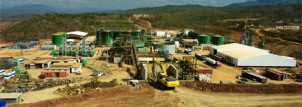
J.G. reports from Malawi. Essay written for the CEECEC course.
Kayelekera is an area in the northern part of Malawi in a district called Karonga. Upon the discovery of uranium in the area, potential mining companies were attracted to it. Among those that bid for the mining rights, Paladin (Africa) Limited (PAL) was the one that won and hence the Kayelekera Mine was born. The company owns 100% of the interests of the mine, but in July 2005 issued 15% of equity in PAL to the government of Malawi under the terms of a Development Agreement signed between PAL and the government in February 2007. Currently, the mine is operational, and has – as promised by both the company and the government – led to an increase in Malawi’s Gross Domestic Product (GDP). This was one of the major reasons the government signed what most critics believe to be a weak deal.
In its early days of inception, the Kayelekera Mine attracted a lot of opposition mainly from CSO’s and environmentalist groups, which led to court hearings. They landed on deaf ears and no significant change was enforced. Indigenous and local people at that time were greatly in favor of it because it symbolized long awaited development to an otherwise neglected area by government. At the time, it appeared as if only the CSO’s and environmental groups were advocating for the rights of the environment.
This situation has now changed. Conflict now exists at several levels of the commodity chain. For example in the transportation of uranium in Malawi, it passes through two major cities, to go the Malawi Zambia border. One of the problems is that Malawi still uses archaic laws and policies that were written before any radioactive material was transported and the liability of the company to the law of Malawi is limited. The problem is further aggravated because the details of the contract between Paladin and the government are unknown to most Malawi citizens. The government though, as proven by a negative statement from the governor of the Federal Bank of Malawi, is no longer convinced of the profitability of the contract.
With time, the indigenous communities of Kayelekera mine have also found a conflicting point with Paladin. It is argued that the problem of employment has not been dealt with as initially expected by the locals. Even for jobs that do not require skilled labor, labor is still brought in from abroad. With time, this has proven to be not only a local community problem but has also expanded to encompass tertiary educated citizens in the country. Due to the influx of both national and international worker migration to the mining site, local prostitution has also seen an increase. This has led to an influx in HIV/AIDS patients which has consequently led to the disruption of normal day to day life in homes where there is an infected person. Local employees are known to have been handing in complaints that they are asked by job requirement to handle raw uranium without proper gear. This is in contrast to even low level foreign employees who have adequate dressing necessary for the handling of raw uranium. Upon interrogation, the superiors are known to have argued that the uranium is of a very low grade and hence can be handled in such a manner, they also denied discrimination against local employees. Currently, as no study has been conducted, there have been no noticeable effects of this exposure to raw uranium. Linked to this is the fact that there are no known independent groups other than consultants hired by an allegedly very corrupt government, that analyze the immediate environment for negative effects, whether short or long term that are or can potentially harm it. Conflict therefore exists at different levels of the commodity chain: from production to transportation and export.



Pingback: Slow #Justice: delays / inaction of #Malawi’s institutions symptomatic of a weak #democracy? | Malawi Ace
Pingback: The real reason why I oppose #drilling for #oil on #lakeMalawi | Malawi Ace